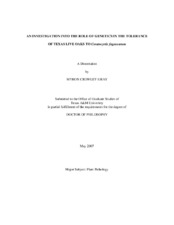| dc.contributor.advisor | Appel, David N. | |
| dc.creator | Gray, Myron Crowley | |
| dc.date.accessioned | 2010-01-15T00:01:16Z | |
| dc.date.accessioned | 2010-01-16T01:40:37Z | |
| dc.date.available | 2010-01-15T00:01:16Z | |
| dc.date.available | 2010-01-16T01:40:37Z | |
| dc.date.created | 2007-05 | |
| dc.date.issued | 2009-05-15 | |
| dc.identifier.uri | https://hdl.handle.net/1969.1/ETD-TAMU-1360 | |
| dc.description.abstract | The fungus Ceratocystis fagacearum (Bretz) Hunt causes the vascular disease of
oak wilt and has been decimating live oaks (Quercus virginiana Mill. and Quercus
fusiformis Small.) and red oaks (Quercus texana Small and Quercus marilandica
Muenchh.) in Texas. The purpose of this research was to test the hypotheses that live
oaks have heritable tolerance to oak wilt, and that allozyme markers are associated with
this tolerance. One-year-old half-sib and two-year-old clonal progeny of live oaks (Q.
fusiformis) were grown from acorns and ramets from a disease center and then challenged
with C. fagacearum.
Allozyme analyses were used to compare the pre- and post-epidemic populations
in two natural disease centers to search for alleles associated with survivability and
decreased crown loss. Half-sib and clonal challenge tests supported the hypothesis that
heritable tolerance to the pathogen occurs in live oaks. The progeny tolerances seen in
half-sib and clonal groups did not correlate with parental tree performance. This finding
suggests that the tolerance of one-year-old seedlings in the greenhouse setting is not a
good predictor of how mature trees will do in a natural setting. Seedlings may not be a
good model for testing tolerance to a pathogen. The ability to survive this vascular
pathogen is containment, and seedlings may be too small to test this type of tolerance.
The clonal groups from post-epidemic trees performed better than the seedlings. They
may have an increased resistance because they are mature or they may have a postdisease
immunity. No significant allele frequencies between pre- and post-epidemic trees
were consistent among sites or with previous research. The different disease sites had
remarkably similar allele frequencies which indicate high levels of gene flow among sites. Both sites were found to contain significant numbers of clones, but the Izoro site
had significantly larger clonal groups.
Sites were in Hardy-Weinberg equilibrium which indicates substantial sexual
reproduction and not just clonal reproduction is taking place. Several cases of linkage
disequilibrium occurred at the Izoro site, but population structure was responsible in all
but one case. | en |
| dc.format.medium | electronic | en |
| dc.format.mimetype | application/pdf | |
| dc.language.iso | en_US | |
| dc.subject | oak wilt | en |
| dc.subject | disease tolerance | en |
| dc.title | An investigation into the role of genetics in the tolerance of Texas live oaks to Ceratocystis fagacearum | en |
| dc.type | Book | en |
| dc.type | Thesis | en |
| thesis.degree.department | Plant Pathology and Microbiology | en |
| thesis.degree.discipline | Plant Pathology | en |
| thesis.degree.grantor | Texas A&M University | en |
| thesis.degree.name | Doctor of Philosophy | en |
| thesis.degree.level | Doctoral | en |
| dc.contributor.committeeMember | Arnold, Michael A. | |
| dc.contributor.committeeMember | McDonald, Bruce A. | |
| dc.contributor.committeeMember | Wilkinson, Heather H. | |
| dc.type.genre | Electronic Dissertation | en |
| dc.type.material | text | en |
| dc.format.digitalOrigin | born digital | en |


